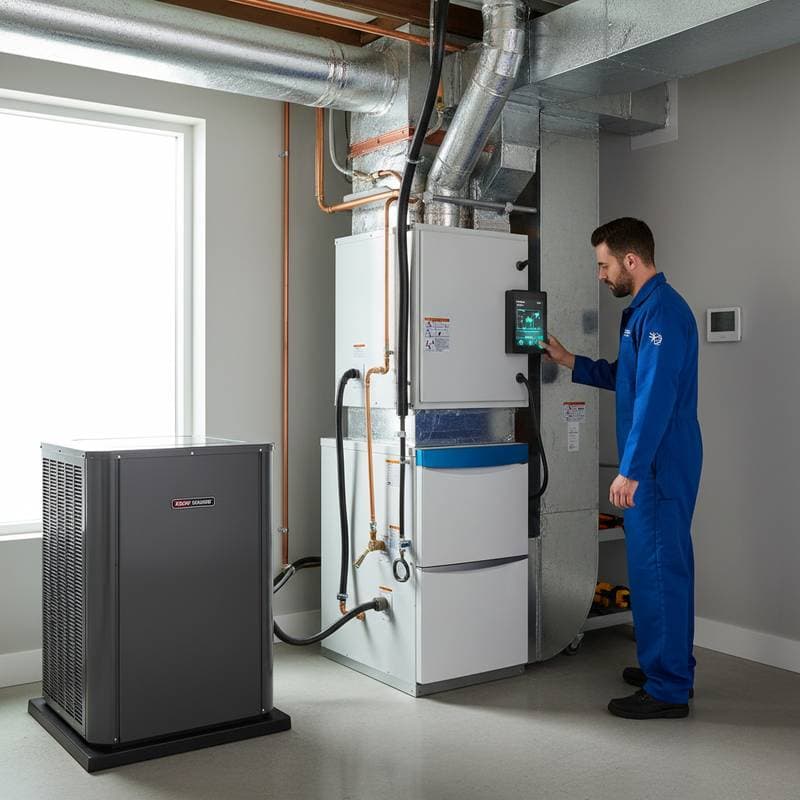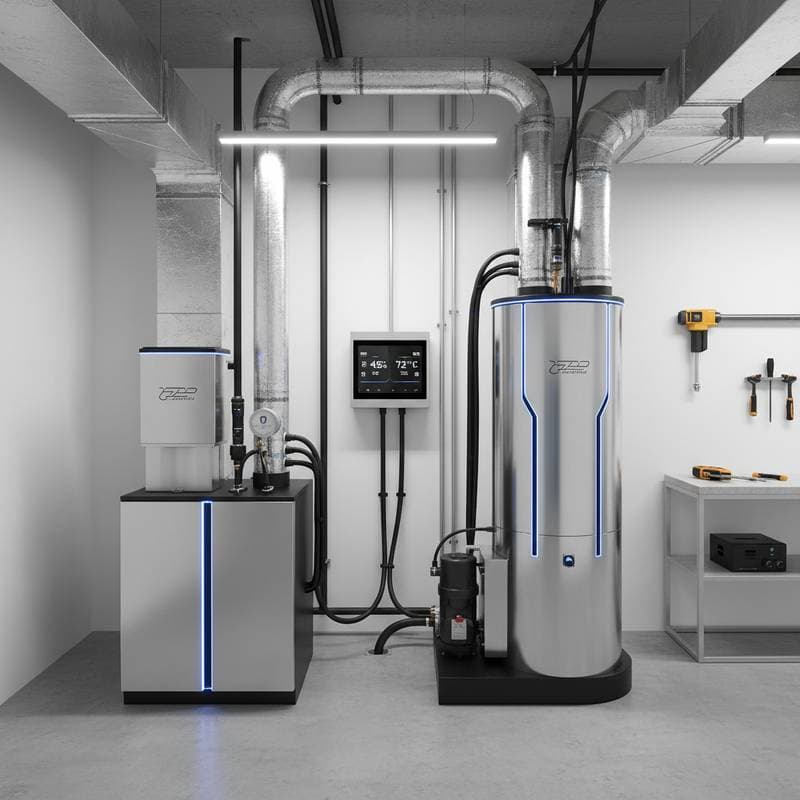Why Dual-Fuel Systems Revolutionize 2025 Heating
Dual-fuel heating systems integrate an electric heat pump with a gas furnace to provide efficient, reliable warmth for homes. These hybrid setups automatically switch between electricity and gas based on outdoor conditions, optimizing performance and lowering energy costs. Homeowners benefit from enhanced comfort, reduced bills, and longer equipment life, positioning dual-fuel technology as a forward-thinking choice for 2025.
Installation for a complete dual-fuel system typically ranges from $8,500 to $14,000, while annual maintenance costs $250 to $750. Upgrading an existing furnace for hybrid compatibility may add $1,500 to $4,000. Factors such as system size, efficiency ratings, and local labor rates influence the final price.
| Service Type | Average Cost |
|---|---|
| Complete dual-fuel system installation | $8,500 to $14,000 |
| Heat pump replacement only | $5,000 to $9,000 |
| Furnace component upgrade | $1,500 to $4,000 |
| Thermostat and control integration | $300 to $1,200 |
| Annual maintenance plan | $250 to $750 |
| Metric | Amount |
|---|---|
| National average cost | $10,200 |
| Minimum cost | $7,000 |
| Maximum cost | $15,000 |
| Average cost range | $8,500 to $14,000 |
Cost data derives from industry research and reported project expenses.
How Dual-Fuel Systems Operate
Dual-fuel systems employ an electric heat pump as the primary heating source during moderate temperatures. When outdoor air cools below a preset level, usually around 35 to 40 degrees Fahrenheit, the system shifts to the gas furnace for stronger output. A smart thermostat or control board oversees this change, ensuring uninterrupted comfort without manual intervention.
The heat pump draws thermal energy from outside air through refrigerant cycles, much like an air conditioner in reverse. In colder weather, the gas furnace activates to supplement heating, preventing efficiency drops. This combination outperforms single-fuel options by balancing cost savings with robust performance across seasons.
Cost Breakdown by System Configuration
Expenses for dual-fuel systems depend on the setup and home requirements. New installations demand full equipment and labor, while retrofits leverage existing components to lower totals.
| Configuration | Average Cost |
|---|---|
| New dual-fuel system with both units | $8,500 to $14,000 |
| Adding heat pump to existing furnace | $6,000 to $10,000 |
| Replacing existing heat pump with dual-fuel model | $7,500 to $12,000 |
| High-efficiency dual-fuel upgrade | $11,000 to $15,000 |
| Smart thermostat integration | $300 to $1,200 |
Labor and Materials
Labor accounts for $2,500 to $5,000, varying with site challenges like access or wiring needs. Materials encompass the heat pump, furnace, controls, refrigerant lines, and any duct adjustments. Larger properties or premium units elevate these figures.
| Cost Component | Average Cost |
|---|---|
| Labor and installation | $2,500 to $5,000 |
| Equipment (heat pump and furnace) | $5,000 to $10,000 |
| Controls and sensors | $300 to $1,200 |
| Ductwork modification | $500 to $2,000 |
Key Factors Influencing Dual-Fuel System Costs
Multiple elements shape the investment in a dual-fuel setup. Homeowners who evaluate these aspects can select options that align with their budget and needs.
- System size: Bigger residences need more powerful units, raising equipment and installation expenses.
- Efficiency ratings: Units with superior SEER and AFUE scores cost more initially but yield greater long-term savings.
- Brand quality: Established manufacturers provide enhanced features, durability, and warranties at a premium.
- Labor complexity: Challenging sites, such as tight spaces or electrical overhauls, extend work time and fees.
- Fuel type: Natural gas options generally prove more economical than propane or oil alternatives.
- Climate zone: Temperate regions favor heat pump dominance, minimizing gas use; harsh winters increase furnace reliance.
- Existing system age: Integrating with outdated infrastructure often requires updates to ducts or power supply.
- Seasonal timing: Off-peak scheduling, like spring or fall, reduces rates due to lighter contractor workloads.
Energy Savings and Performance Advantages
Dual-fuel systems achieve notable efficiency over conventional heaters by prioritizing the heat pump in suitable conditions. This approach cuts energy use by 20 to 30 percent annually, translating to substantial bill reductions. The furnace engages only as needed, preserving overall system health.
Hybrid operation also prolongs durability. Components function in their ideal ranges, minimizing strain and breakdowns. Expect 15 to 20 years of service from a properly maintained unit, compared to 10 to 15 years for standard furnaces.
| Efficiency Metric | Dual-Fuel System | Traditional Furnace |
|---|---|---|
| Average energy efficiency | 85% to 95% | 75% to 90% |
| Annual energy savings | 20% to 30% | N/A |
| Expected lifespan | 15 to 20 years | 10 to 15 years |
Related Costs and Additional Expenses
Account for ancillary items to maintain compliance and functionality post-installation.
| Related Service | Typical Cost |
|---|---|
| HVAC permit and inspection | $150 to $500 |
| Old system removal | $300 to $800 |
| Electrical panel upgrade | $400 to $1,200 |
| Gas line modification | $250 to $900 |
| Annual system maintenance | $250 to $750 |
Regional differences and provider choices affect these amounts. Insist on comprehensive quotes covering all elements.
Maintenance and Care Guidelines
Regular upkeep sustains peak performance and averts costly issues in dual-fuel systems. Professional servicing once a year proves essential for hybrid reliability.
Recommended tasks include:
- Arranging annual inspections by certified technicians.
- Changing air filters every one to three months.
- Clearing coils on the outdoor heat pump unit.
- Verifying thermostat accuracy for fuel transitions.
- Inspecting refrigerant and gas lines.
- Removing debris near external components.
These steps support smooth operation, particularly during weather shifts.
Repair Versus Replacement Decisions
Assess system age and repair expenses when troubleshooting arises. Units over 15 years old rarely warrant extensive fixes. Opt for replacement if costs surpass 40 percent of a new system's price.
Indicators favoring upgrade include escalating utility payments, inconsistent temperatures, repeated service calls, or obsolete controls. Newer models deliver quieter runs, smarter features, and superior energy management.
Strategies to Reduce Dual-Fuel System Expenses
Thoughtful choices trim initial outlays and sustain savings over time.
- Schedule work in low-demand seasons for competitive pricing.
- Seek utility rebates on efficient installations.
- Obtain bids from several licensed professionals.
- Combine with other HVAC improvements for discounts.
- Select efficiency levels that match usage without excess.
- Install programmable thermostats for precise control.
- Commit to routine maintenance to prevent breakdowns.
- Implement zoning to target heating where needed.
Frequently Asked Questions About Dual-Fuel Systems
How Much Does a Dual-Fuel System Cost?
A full installation averages $8,500 to $14,000, covering units and setup. Retrofitting a heat pump onto a current furnace falls between $6,000 and $10,000.
Is a Dual-Fuel System Worth the Investment?
Affirmative. Lower operating costs and improved reliability often recoup the premium within a few years.
How Long Does a Dual-Fuel System Last?
With consistent care, expect 15 to 20 years of reliable service.
Can I Convert My Existing Furnace into a Dual-Fuel System?
Often possible, provided ducts and the furnace suit integration. A technician evaluates compatibility.
What Is the Best Temperature for Switching Between Fuels?
Systems typically shift at 35 to 40 degrees Fahrenheit. Adjustments tailor to climate and rates.
Do Dual-Fuel Systems Work with Propane?
Yes, propane furnaces integrate effectively in gas-scarce regions.
How Does a Dual-Fuel System Compare to a Standard Heat Pump?
Standard pumps use electricity alone and falter in severe cold. Dual-fuel adds gas backup for consistent results.
Are There Rebates or Incentives for Hybrid Systems?
Utilities and makers frequently provide credits for efficient hybrids. Verify local offerings.
How Noisy Are Dual-Fuel Systems?
Modern units operate quietly, with heat pumps at 50 to 60 decibels and furnaces slightly louder during cycles. Placement and insulation further dampen sound.
Who Should Install a Dual-Fuel System?
Engage licensed HVAC contractors experienced in hybrids to ensure code compliance and performance.
Selecting Reliable Contractors for Installation
Choose installers with proven expertise to safeguard your investment.
- Confirm valid state and local HVAC licenses.
- Verify insurance and bonding coverage.
- Inquire about dual-fuel project history.
- Demand itemized written proposals.
- Review client feedback and references.
- Gather at least three competitive quotes.
- Check for manufacturer training certifications.
- Clarify warranty terms for parts and workmanship.
- Discuss timelines and contingency plans.
- Explore ongoing maintenance packages.
Maximizing Returns on Your Dual-Fuel Setup
Integrate smart home devices to monitor and adjust operations remotely. Track energy use through apps to identify savings opportunities. Pair with insulation upgrades for amplified efficiency, ensuring your system delivers lasting value and comfort year-round.



